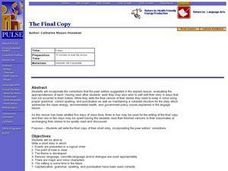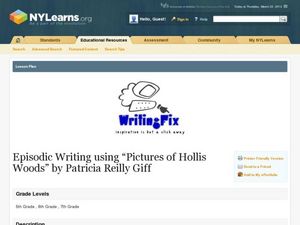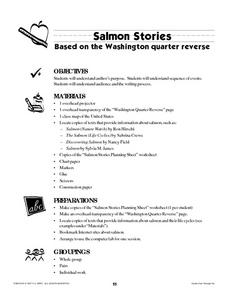Curated OER
Primary Sources and Protagonists: A Native American Literature Unit
Introduce your middle schoolers to the lives of past Native Americans. First, learners work together to put photographs in a sequence. Then, using their sequence, they create stories to share with the whole class. No matter how old your...
Curated OER
Old Lady That Swallowed a Fly
Youngsters listen to the story, "There Was an Old Lady Who Swallowed a Fly." After discussing the story, going over new vocabulary, and repeating the rhymes in the story, they study the parts of a fly. They finish by creating a fly on...
Curated OER
What is a Philanthropist?
What does a philanthropist do? Help your class explore philanthropy using character development and literacy ideas. Learners will define and give examples of philanthropy, listen to The Lion and the Mouse, discuss how the characters help...
Curated OER
ELD Lesson Plan: Courage
What is true courage? Your class can explore the answer with these three Houghton-Mifflin stories ("Hatchet," "Passage to Freedom," "Climb or Die," and "The True Confessions of Charlotte Doyle"), which feature courageous characters and...
Curated OER
Introduce Vocabulary: Kindergarten Count to 100 (Rogers)
Combine counting and vocabulary in context using Jacqueline Rogers' Kindergarten Count to 100. Suggested words for this text are: first, fountain, salute, second, and third. By introducing the terms before reading the text,...
Curated OER
Mo Willems Author Study
Who is Mo Willems? Explore the author with your class. Learners read books written by Willems, compare and contrast the characters therein, and make predictions about what will happen. Finish off this author study by having small groups...
Curated OER
The Final Copy
Write short stories in which events are presented in logical order, point of view is clear, theme and characters are developed. Middle schoolers also work on sensory language, concrete language and/or dialogue. They establish their...
Curated OER
Episodic Writing Using Pictures of Hollis Woods by Patricia Reilly Giff
Help your middle-schoolers expand their writing skills with this lesson on episodic writing, which focuses on story details, idea development, and organization. After reading "The Eighth Picture: End of Summer" from Patricia Reilly...
Hawaiʻi State Department of Education
Sequence of Events
Are you in need of a new way to teach learners sequence of events and how to interpret a character's external motivations? Why not engage them in dramatic play? The class will use tableaux to convey the sequence of events in a familiar...
Curated OER
The Little Red Hen: Lesson
After hearing the classic version of The Little Red Hen, pre-schoolers use the sequence of events and ordinal position words to construct a version of their own. They use stick puppets to retell the story, with updated modifications that...
Curated OER
Stone Soup
Students examine the topics of conflict, resolution, and solution using the book "Stone Soup." They create a class pictograph using real vegetables brought in by the students, answer story comprehension questions, and sequence the events...
Curated OER
"The Magic Apple"
Students complete a variety of activities that correspond with the book "The Magic Apple" by Rob Cleveland. They answer story comprehension questions, then complete a story sequencing worksheet. Students also complete a "Matching Letters...
Curated OER
Developing a Topic for Writing Using an Idea Web
Teach your upper graders how to use an idea web to develop a topic for writing. After reading a variety of stories about friendship (a list of stories with the theme of friendship is included), model using an idea web. Class members...
Curated OER
Salmon Stories
Work on author's purpose with this instructional activity, which focuses on sequence of events and audience as well. Middle and high schoolers describe the 50 State Quarters Program for background information. After discussing the...
Hawaiʻi State Department of Education
Making Dances From Stories
After reading a short story, learners will create dances that show homophones and verbs. Their dance sequences involve three verbs and transition movements in between each verb. Tip: Have the class dance out the sequence of events from...
Curated OER
Comprehension Skills: Evaluate Using Fiction Stories and Aesop's Fables
Primary readers investigate several comprehension skills in the ten lessons of this unit. Forming opinions about stories, comparing stories to each other, using Venn Diagrams, and applying the ideas from a story to real life situations...
Hawaiʻi State Department of Education
Story Design
Stories contain very specific elements; plot, characters, and key events. Learners use pantomime to retell a key event from the beginning, middle, and end of a story. They discuss setting and character as each group discusses and then...
Curated OER
A Backward Day
In this writing worksheet, students think about what they did yesterday, but tell the events in backwards order from the events at the day's end to the beginning. Students read the story starter and finish the story.
Curated OER
Retelling Problems and Solutions in Chronological Order
First graders discover how to retell problems and solutions in a story in chronological order. In this chronological order lesson, 1st graders use graphic organizers to record information. Students then use this information to sequence...
Curated OER
Sequence of Events Storyline
Seventh graders practice sequencing the events in a story they have read. After reading a short story, 7th graders sequence the events of the story using a timeline. Their timeline is used to create a summary paragraph of the story...
Curated OER
Sequence and Retell - The Napping House
Students sequence the story The Napping House by keeping trace of the characters in order. In this sequencing lesson plan, students also retell the story as they sequence.
Curated OER
Comprehension: Understanding "sequence"
Second graders read the story The Broken Bed and then sequence the story in their own words. In this sequencing lesson plan, 2nd graders also write narrative with a specific beginning, middle, and end.
Curated OER
Story of Silk
Students investigate the steps of the silk-making process through a reading of the story, "The Empress and the Silkworm" by Toy Hong. Sequencing cards are utilized to enhance the process and a silkworm's cocoon is unravelled.
Curated OER
How can we write a silly story?
Second graders use the writing process and create a silly story. In this silly story instructional activity, 2nd graders will review person, event and setting and complete a chart for each. Students will put a person,...
Other popular searches
- Story Sequencing
- Story Sequencing Worksheets
- Picture Story Sequencing
- Story Sequencing Halloween
- Story Sequencing Activities
- Story Sequencing Rubric
- Sequencing Story Events
- Short Story Sequencing
- Story Sequencing Exercises
- Story Sequencing Pictures
- Story Sequencing Map
- Story Sequencing Lessons























